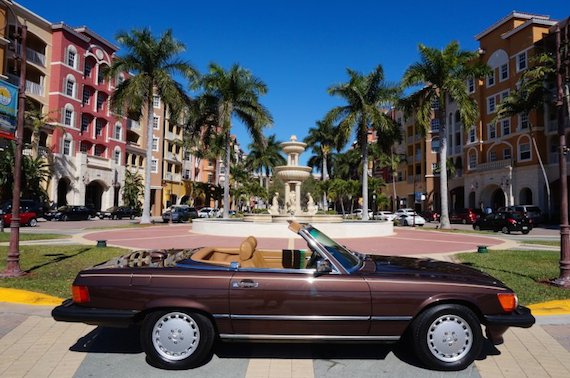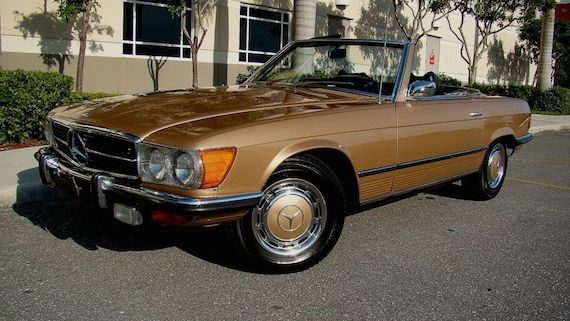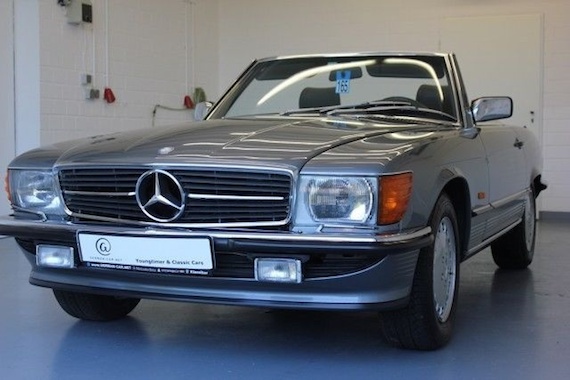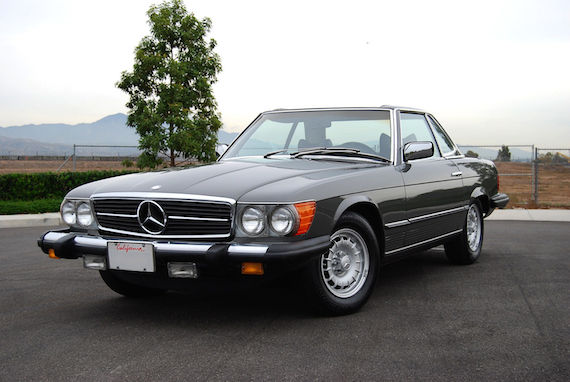After sizing up that Audi A5 in Teak Brown over the weekend, I came across this lovely, low mileage 1986 Mercedes-Benz 560SL in a not often seen shade of Manganese Brown. Metallic browns have made a comeback recently on cars, no longer being a hue relegated to the decade which brought us disco, an oil crisis and Mayor Ed Koch. The 560SL is one of those German classics that has been rising in visibility amongst collectors. As such, values are beginning to push upwards for what is likely to be the next SL collector vehicle domino to fall. The appear small, but they drive like a much bigger vehicle, if the few I’ve had the chance to pilot over the years are any indication. The legendary bank vault construction is there but the ride quality has a decidedly soft nature about it. They are immensely capable as grand touring machines, but have a bit of float on the twisty bits with the nose rising under acceleration, almost giving you the feel as if you are on a small boat.
Tag: R107
Few knew it at the time, but 1972 would be the introduction for one of the longest lived Mercedes-Benz models of all time, the R107 SL. It was a departure from the W113 SL, more boulevard cruiser than “sports light†special. The first R107s to make it to the US would be the 350SL, but contrary to what the badge on the trunk lid may suggest, this SL did not have a 3.5 liter V8 under the hood. Customers stateside would get a detuned 4.5 liter V8 meant to cope with ever tightening emissions standards. Then in 1974, large crash bumpers would make their appearance, further differentiating the US market SL from their counterparts abroad. This 1972 350SL for sale in Florida has a golden hue fitting for the Sunshine State.
Click for details: 1971 Mercedes-Benz 350SL on eBay
Comments closedThe R129 Mercedes-Benz SL was a car met with much anticipation at the end of the 1980s, as the existing R107 SL had been in production since the early 1970s. Few models have had such longevity in the Mercedes product range. In a departure from prior models, both a six-cylinder (300SL) and V8 (500SL) would be offered in the new model. Customers could even opt for a 5-speed manual in the US market with the 300SL, but takers were few, making the early R129s with three pedals quite the rarity. The R107 was available with a six-cylinder engine all along in other markets, culminating with the similarly badged 300SL in 1986 that would cease production along with the rest of the range after the 1989 model year. These two 300SLs here represent possibly the best of the best when it comes to the six-cylinder/manual transmission combo in SLs of yore. We’ll start with this 1988 300SL for sale in northern Germany with a remarkably low 27,000 miles on the clock.
Click for details: 1988 Mercedes-Benz 300SL on eBay
2 CommentsThe 1970s were generally seen as a pretty harsh time for the automobile. It was the end of the era for large American sedans with big V8s under the hood and muscle cars. Consumers in the US turned to a myriad of imported subcompact cars to combat ever rising fuel prices. Things stayed fairly consistent at Mercedes-Benz, with exception of some larger bumpers and lighting differences as compared to their European market counterparts. Through it all, from 1972 to 1989, there was one car that defined the brand, the R107 SL roadster. Whether it was cruising the Sunset Strip or going on a weekend jaunt to The Hamptons, the SL was the car to be seen in during that era. I generally prefer the later 300SL and 560SL variants, but this 1977 450SL for sale in California has caught my attention. For the mileage, the car presents very well and the Anthracite Grey over black MB-tex livery gives it an almost timeless vibe.
Click for details: 1977 Mercedes-Benz 450SL on eBay
4 CommentsWhile there are some great tuners from the 1980s whose designs seems classic and timeless, there seem to be many more whose designs are massively polarizing. For every spectacular Ruf, AMG and Alpina that’s out there, there seem to be an equal or greater amount of Gemballas, Stroseks, DPs, Koenigs and Tresers. The modifications they undertook were expensive and generally outrageous. It also seems that often they were discarded by their deep pocketed builders once they were no longer in fashion – if they ever were. But even if they weren’t the most attractive, they’re still cool timepieces to look back on a decade that defined excess through conspicuous consumption. I can’t help but wonder what the trends of today are that we’ll look back upon with the same attitude as we judge the 1980s. One of the tuners that seems to skirt between garish and great is Lorinser – not so wild as the Testarossa vented Koenigs, but generally I’d say not as good looking as the AMGs, either:




